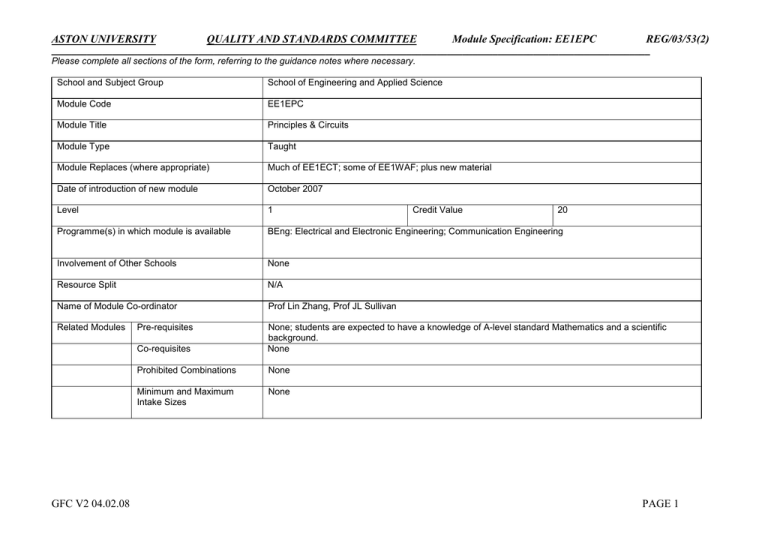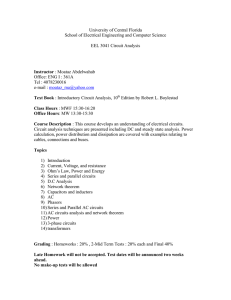
ASTON UNIVERSITY
QUALITY AND STANDARDS COMMITTEE
Module Specification: EE1EPC
REG/03/53(2)
______________________________________________________________________________________________________________________
Please complete all sections of the form, referring to the guidance notes where necessary.
School and Subject Group
School of Engineering and Applied Science
Module Code
EE1EPC
Module Title
Principles & Circuits
Module Type
Taught
Module Replaces (where appropriate)
Much of EE1ECT; some of EE1WAF; plus new material
Date of introduction of new module
October 2007
Level
1
Programme(s) in which module is available
BEng: Electrical and Electronic Engineering; Communication Engineering
Involvement of Other Schools
None
Resource Split
N/A
Name of Module Co-ordinator
Prof Lin Zhang, Prof JL Sullivan
Related Modules
Co-requisites
None; students are expected to have a knowledge of A-level standard Mathematics and a scientific
background.
None
Prohibited Combinations
None
Minimum and Maximum
Intake Sizes
None
GFC V2 04.02.08
Pre-requisites
Credit Value
20
PAGE 1
ASTON UNIVERSITY
QUALITY AND STANDARDS COMMITTEE
Module Specification: EE1EPC
REG/03/53(2)
Aims of the Module
To provide a broad introduction of fundamental concepts, principles and analysis techniques of electrical engineering to enable higher level study in the subject. The
module will concentrate on:
•
the fundamentals of electrical DC and AC circuits.
•
a basic understanding of electrostatics, magnetostatics and electromagnetics.
•
an introduction to waves and wave motion with emphasis on optical waves.
with particular application to electrical and electronic engineering.
Summary of Content
Electrical DC and AC circuits.
•
Basic electric field theory and electricity. Fundamentals of DC circuit analysis. Network theorems.
•
Capacitance and inductance. Time-dependent response of R-C, R-L and R-L-C circuits.
•
Computer simulation. PSPICE for circuit analysis
•
Fundamentals of AC circuits. Application of phasors.
•
Series and parallel AC circuits and networks. Filters and resonant circuits
•
Electrical power
Concepts of electrostatics
•
Coulomb's law; electric field E and potential V due to point and distributed charge systems.
•
Introduction to Gauss's Theorem, electric displacement D, E and V due to charged conductors.
•
Capacitance revisited: capacitive systems, dielectric media, polarisation and susceptibility.
Concepts of electromagnetics
•
Biot-Savart Law; permeability of free space, magnetic induction B.
•
Introduction to Ampere's Circuital Law; B due to straight wires, short coils and solenoids.
•
Faraday-Lenz Laws; induced emf due to a rotating current loop, principles of dynamos and alternators, inductance in simple coil systems.
•
Electromagetic forces; moving coil galvanometer and electric motor, behaviour of charged particle beams, cathode ray tube.
Introduction to waves
•
Progressive waves and standing waves; longitudinal and transverse waves. Overview of mathematical notation.
•
Phase and group velocities, dispersion.
•
Introduction to the concepts of superposition, coherence. Interference between waves; diffraction.
•
Polarisation.
Summary of Methods and Frequency of Teaching
Contact hours spread over teaching periods 1 and 2:
GFC V2 04.02.08
Lectures:
Tutorials:
Laboratory:
Private study:
24 x1 hour
12 x 1 hour
12 x 3 hours
128 hours
PAGE 2
ASTON UNIVERSITY
QUALITY AND STANDARDS COMMITTEE
Module Outcomes – what the student should gain from successful completion of the module:
Module Specification: EE1EPC
REG/03/53(2)
Learning and Teaching and Assessment Strategies to enable
outcomes to be achieved and demonstrated
Learning and Teaching
Methods
Assessment Methods
Lectures, recommended reading,
laboratory exercises, and case
studies
Examination, class test,
laboratory reports, case studies
Lectures, laboratory exercises,
case studies, tutorial problems,
recommended reading
Examination, class test and
laboratory reports, case studies
Lectures, laboratory exercises,
case studies, tutorial problems
Examination, class test,
laboratory reports, case studies
Lectures, laboratory exercises,
tutorial problems
Laboratory reports, case studies
Knowledge and Understanding of
•
•
•
•
•
The basics of mathematics and science underpinning electrical circuits.
The fundamental concepts of electrostatics, electromagnetics and waves.
The fundamental principles of circuit theory.
Design techniques appropriate to circuit theory.
The use of test and measurement equipment for circuit characteristics.
Intellectual Skills
•
•
•
•
Ability to analyse and design appropriate experiments.
Ability to evaluate relevant information from a variety of sources.
Ability to evaluate and interpret experimental measurements.
Problem solving involving circuits, and fields and waves.
Professional/Subject Specific Skills
•
Ability to plan and carry out experiments using appropriate methods and techniques.
Transferable Skills
•
•
•
Enhanced information gathering skills for the physical sciences
Management of time and resources
Self-study and independent learning skills
Please provide either or both of:
Introductory Learning Resources
Core Texts
Reading Lists
GFC V2 04.02.08
Extensive Lecture notes
“Introductory Circuit Analysis”, 9/e and10/e, 11/e, Robert L. Boylestad, Prentice-Hall
“Electric Circuits”, 2/e, Theodore F. Bogart, McGraw-Hill, 1992
“Electric Circuits Fundamentals”, 7/e, Thomas L. Floyd, Pearson Prentice Hall, 2006
“Introduction to Electric Circuits”, 5/e and 6/e, Richard C. Dorf and James A. Svoboda, Wiley, 2001
“Electric Circuits”, 6/e, James W. Nilsson and Susan A. Riedel, Prentice-Hall, 2000
“Basic Engineering Circuit Analysis”, 6/e, J. David Irwin and Chwan-Hwa Wu, Wiley, 1999
“Circuit Analysis”, 2/e, Cunningham Stuller, Wiley, 1995
“Electric Circuit analysis”, 3/e, David E. Johnson, Johnny R. Johnson, John L. Hilburn and Peter D. Scott, Wiley, 1999
“Electromagnetism for Engineers – An Introductory Course”, 4/e, P. Hammond, , Oxford Science Publications, 1997
“Introduction to Electrodynamics”, 3/e, David. J. Griffiths, Prentice Hall, 2003, ISBN 0-13-919960-8
“Engineering Electromagnetics”, 6/e, William H. Hayt, Jr. , John A. Buck, McGraw Hill, 2001, ISBN 0-07-120229-3
“Electromagnetism for Electronic Engineers – Tutorial Guides in Electronic Engineering”, 2/e. G. Carter, , Chapman & Hall, 1992,
ISBN 0-412-42740-0
“Optics”, 4/e, Eugene Hecht, Addison Wesley Longman, 2002, ISBN 0-8053-8566-5
“Worked Problems in Optics”, Alan H. Tunnacliffe, MI Associates, 2000, ISBN 0-900099-16-17
“Modern Optics”, Robert Guenther, John Wiley & Sons, 1990
PAGE 3
ASTON UNIVERSITY
QUALITY AND STANDARDS COMMITTEE
Specification completed by:
Lin Zhang; JohnSullivan
Date
07.09.07 (re-formatted 04.02.08)
Date module approved by Teaching Committee(s)
January 2008
Module Specification: EE1EPC
REG/03/53(2)
Date module approved by School Board(s)
RPS/SJD/DLL/Module Specification/24 March 2003(f)
SJD/LAP/Module Programmes.
GFC V2 04.02.08
PAGE 4





